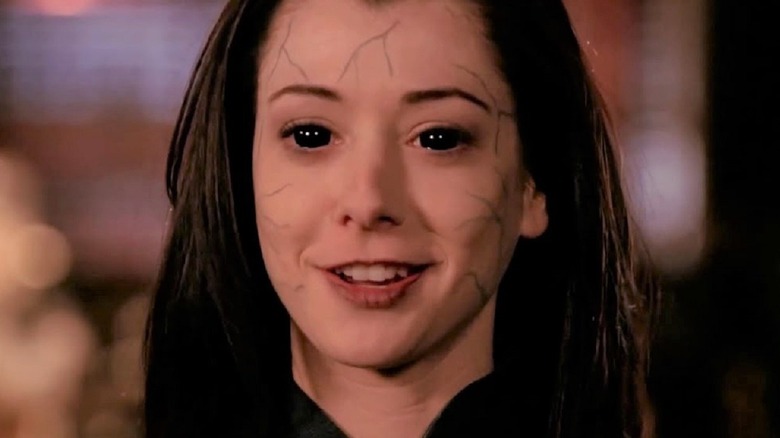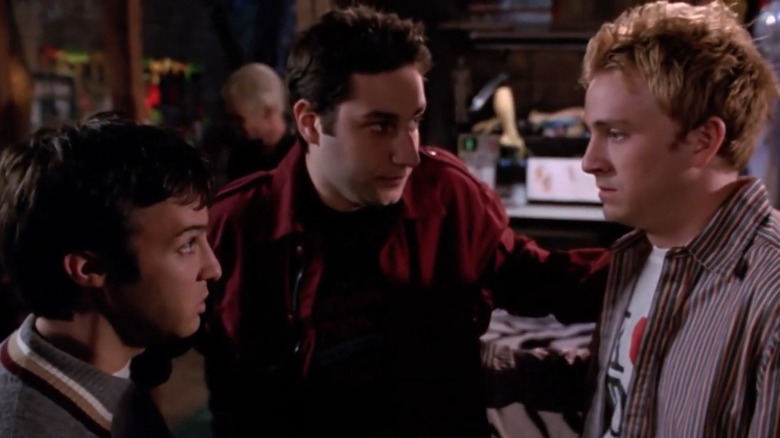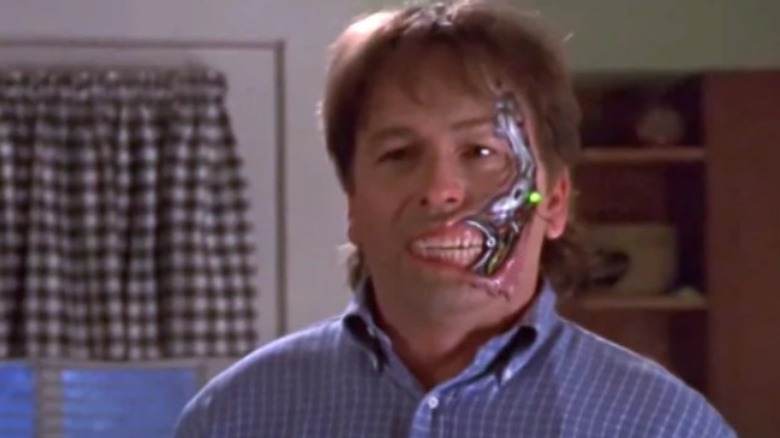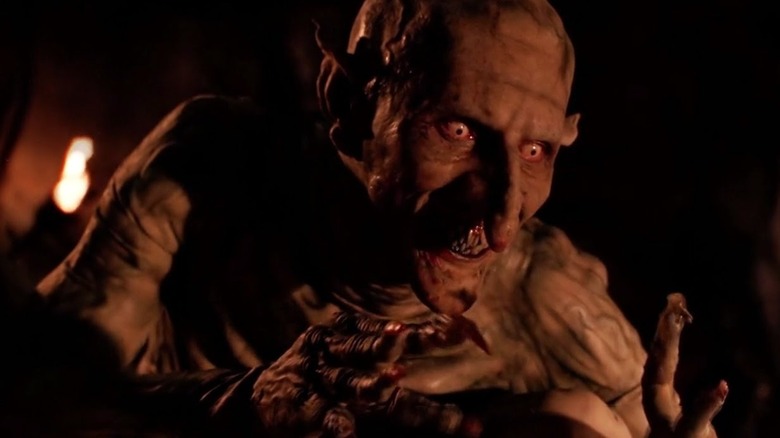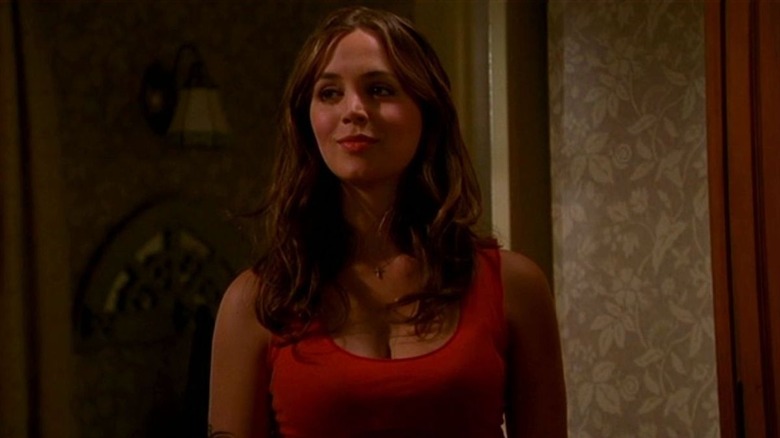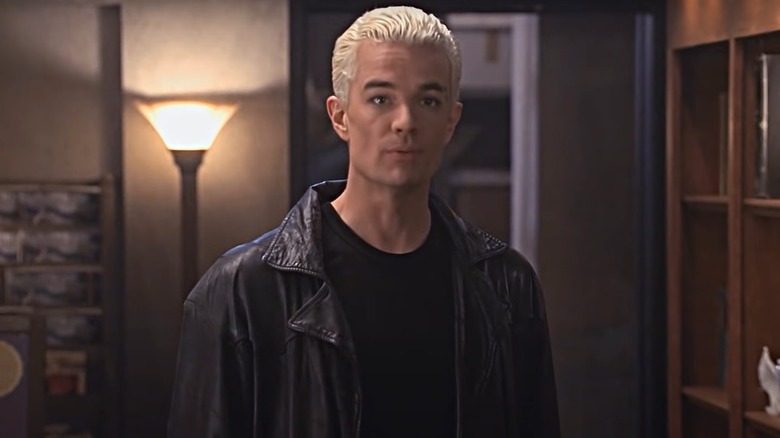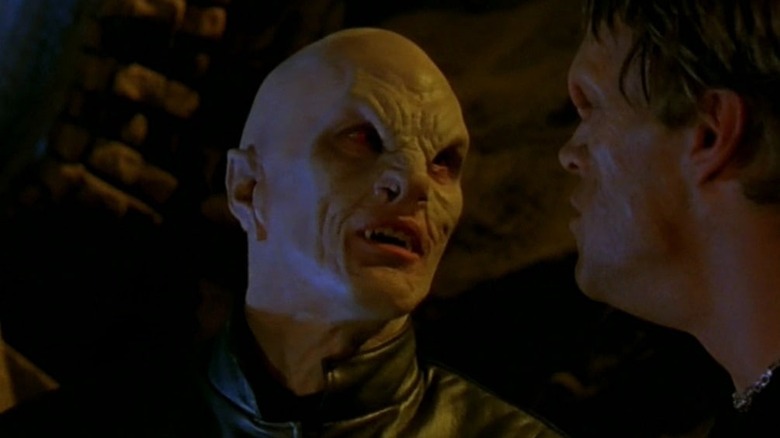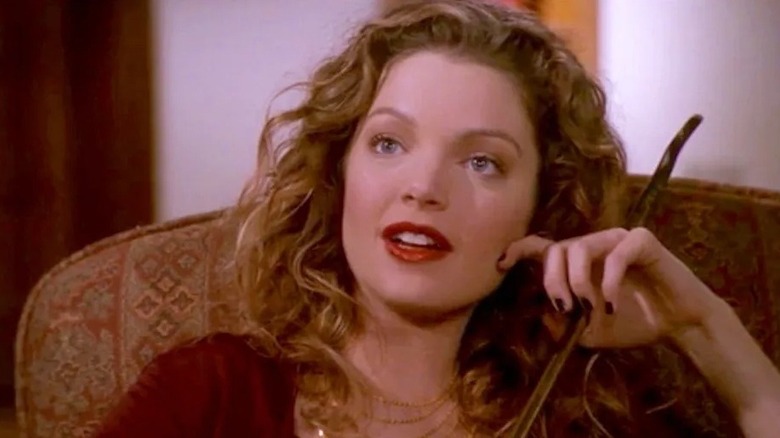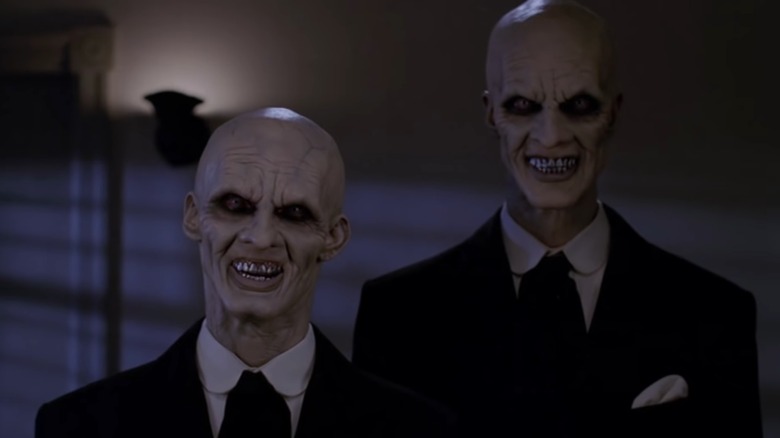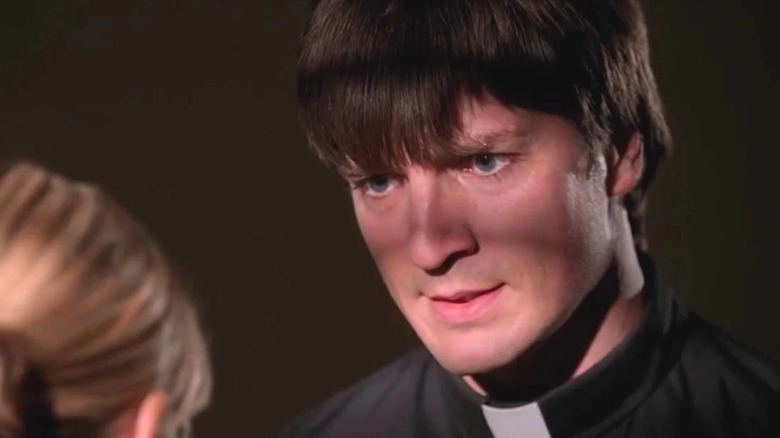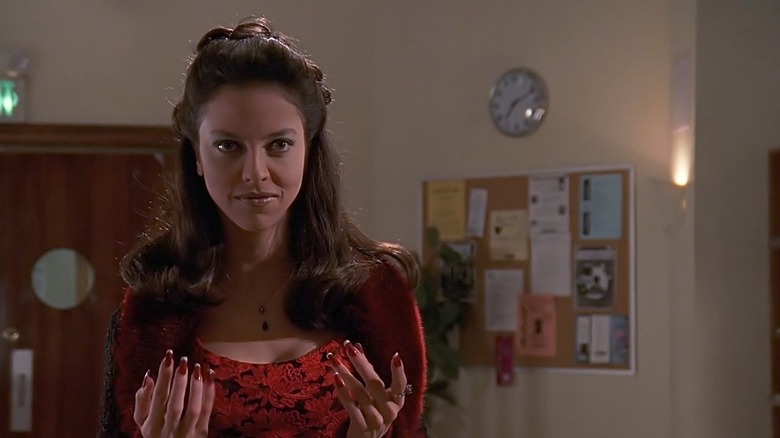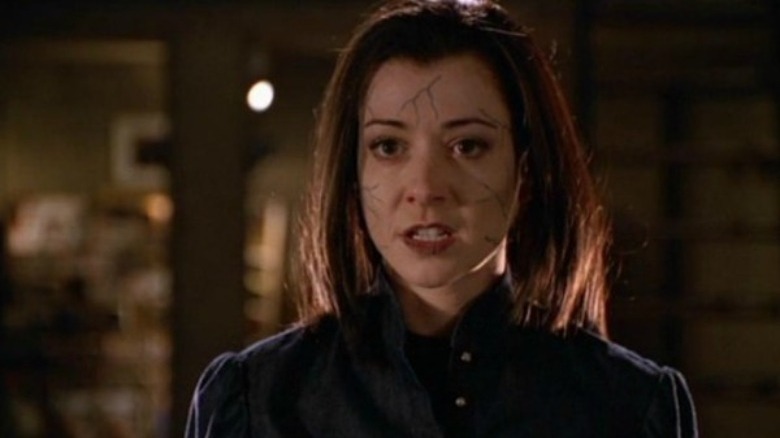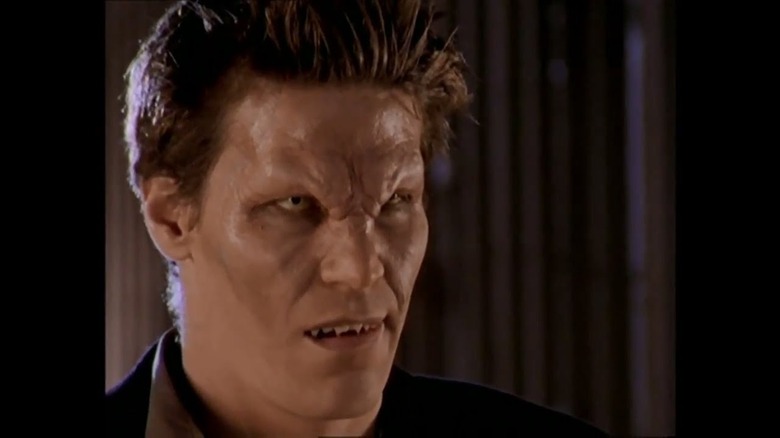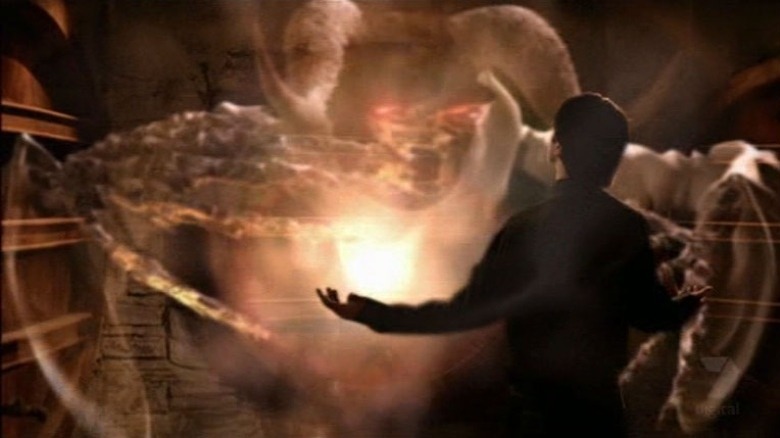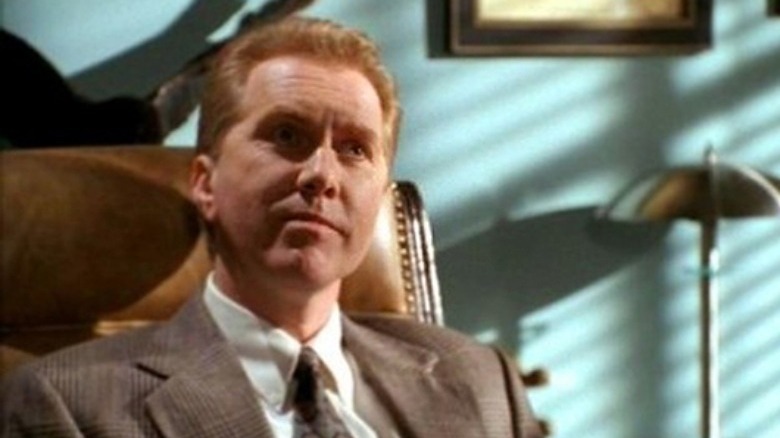The Best Buffy The Vampire Slayer Villains Ranked
Considering "Buffy the Vampire Slayer" was the show that originated the term "Big Bad" — usually referring to a major mastermind villain — it makes sense that the series would be the home of some of the most charismatic antagonists on TV. From charming children of the night to chilling, frozen-faced demons, "Buffy" delivered some memorable bad guys over the course of its seven seasons.
While many of the series' best villains were Big Bads — dominating the heroes' efforts for a season — some were one-off bad guys who never showed up again but left a powerful impression. And some of the best villains would eventually become allies to Buffy (Sarah Michelle Gellar), and other antagonists who would wind up threatening the world actually started off on the side of the angels.
From demons to witches to local politicians, here are the greatest villains of "Buffy the Vampire Slayer," ranked from worst to best.
Warning — there are spoilers below.
The Trio were hilarious ... until they weren't
Appearing together for the first time in the penultimate sixth season of "Buffy," each member of the Trio had a connection to the series' past. Jonathan (Danny Strong) had appeared as a recurring character since Season 2, even once famously casting a spell that made him replace Buffy as the show's hero. Warren (Adam Busch) first appeared in Season 5, when Buffy has to protect him from a robot girlfriend he built. And it's Andrew's (Tom Lenk) brother who summons demons to attack Sunnydale High in Season 3's "The Prom."
Love 'em or hate 'em, the Trio proved to be one of the funniest groups of villains ... until they stopped being funny at all. With a combination of magic and high-tech gadgetry, the Trio cause plenty of trouble for Buffy in Season 6, though rarely with any overall plan in mind. They summon demons and invent a freeze ray, but they're mainly played for laughs. That is, until Warren — incensed at being defeated by Buffy — unintentionally kills Tara (Amber Benson) in what proves to be perhaps the most hated moment in the series.
Of the three villains, the only one to survive the series is Andrew, who joins forces with Buffy and her friends in the final season.
Ted only showed up once, but that was enough
In Season 2's "Ted," Buffy's mother, Joyce (Kristine Sutherland), has a new boyfriend. Unfortunately, not only is he not the gentleman he pretends to be, he's not even the human he pretends to be. While Ted (John Ritter) acts like nothing but the most supportive and loving boyfriend in the world when Joyce is around, as soon as she's out of earshot, Ted is verbally and physically abusive to Buffy.
Laying his hands on her seems to be his last mistake — when Buffy defends herself, Ted winds up with his neck broken. But it turns out Ted isn't really Ted. When Buffy's friends search his apartment, they discover the real Ted Buchanan has been dead for decades. The one Buffy "killed" isn't a demon like most of her enemies but a robot who comes back to life and has to be put down hard.
Even though this is the only appearance of Ted, it's tough to forget him. The late Ritter acts hard against type, playing not only a creepy villain but an abusive older man. After seeing the finished product, it's a wonder Ritter wasn't cast as a villain more often.
Gnarl was one of Buffy's scariest monsters
While he lives and dies exclusively in "Same Time, Same Place" — an early episode of the final season — the flesh-eating demon Gnarl (Camden Toy) is one of the most terrifying villains to ever show up on "Buffy." His appearance coincides with the return of Willow (Alyson Hannigan) to Sunnydale, who's afraid that her friends won't want to see her after not only committing murder but almost ending the world in the Season 6 finale. That fear has her unconsciously use her magic to make herself invisible to her friends and her friends invisible to her.
Gnarl uses Willow's predicament to his advantage to kidnap and almost kill her, paralyzing her and feasting on strips of her flesh. Gnarl's design is perhaps the most visually striking of any of the various monsters and demons on "Buffy," and the fact that we actually see him eat the strips of skin off Willow crosses a line that helps render him even more frightening.
Faith is who Buffy could have been
Buffy Summers isn't the only Slayer we meet in the series. In Season 2, we're introduced to Kendra (Bianca Lawson), and after her death, she's replaced with the much rougher Faith (Eliza Dushku). As opposed to the disciplined Kendra who treats Buffy's watcher, Giles (Anthony Stewart Head), like a revered elder, Faith is wilder and less disciplined than Buffy.
When Faith first arrives in Sunnydale, Buffy enjoys joining the new Slayer in her untamed revels, but that's before Faith kills a human on accident. That kill — and Faith's attempts to hide it — puts her on a dark path that eventually finds her acting as personal bodyguard to Mayor Richard Wilkins (Harry Groener) — the Big Bad of Season 3. By the end of the series, however, Faith has changed her ways, and she joins Buffy in her fight against the First.
Faith is one of the most tragic figures in "Buffy." While some of the things she does seem unforgivable, the truth is that Faith is what Buffy would be without Giles or her other friends to help and guide her.
Spike was a fun villain, even when he was neutered
Looking like Billy Idol and feeling a lot more punk rock than the fanatical vampires of the inaugural season, the vampire Spike (James Marsters) proved so popular in "Buffy" Season 2 that he would grow from a minor villain to a recurring villain. And eventually, he'd transform into one of Buffy's allies and even a love interest. In fact, he was so popular that even though he dies a hero in the "Buffy" finale, he's later resurrected to become a series regular on the final season of "Angel."
Spike becomes something on an unwilling ally to Buffy in Season 4 when the Initiative implants a microchip in his head that stops him from attacking humans. Initially, he helps out Buffy and the Scoobs because fighting other demons is the only violence he's allowed. But it isn't really until Season 7, when Spike regains his soul, that he truly stops being a villain. Until then, he's simply leashed.
Many of Buffy's best villains came from the Master
What Season 1's Big Bad, the Master, lacks in a creative name, he makes up for in a surprising amount of charisma and humor, not to mention sheer ruthlessness. Far more powerful than most vampires, the Master's bloodline is responsible for many of the Buffyverse's most formidable recurring vampire characters, such as Angel (Dave Boreanaz), Darla (Julie Benz), Drusilla (Juliet Landau), and Spike.
Mark Metcalf of "Animal House" fame plays the Master, and he actually had more input in the design of the character than you might expect. In a 2015 interview on the "Whedonverse Podcast," Metcalf said that the original plan was for his character to have long, black hair and to have an "angular" look. The actor said he was the one who suggested instead taking inspiration from the 1922 silent film "Nosferatu," whose villain — Count Orlok — was bald with pointed ears like the Master.
Glory is one the toughest Big Bads
Better known as Glory, the hell goddess Glorificus (Clare Kramer) is one of the first Big Bads who seems genuinely unbeatable. Cursed by other hell gods to spend her existence in the vessel of the mortal man, Ben (Charlie Weber), Glory is determined to sacrifice Buffy's sister, Dawn (Michelle Trachtenberg), in order to get herself back to her home dimension.
As crazy and charismatic as she is deadly, Glory brings Buffy and her friends to the brink like no one before, so much so that toward the end of the season, Buffy does the unthinkable and actually tries to flee Sunnydale with Dawn and her friends. Glory's reign of terror is so complete she manages to give us a preview of another "Buffy" bad guy. In order to have the strength to stay sane, Glory drains the sanity from humans. She uses this ability on Tara in Season 5's "Tough Love," which sends Willow into a rage. Accessing dark books and forbidden magic, Willow assaults Glory in something of a precursor to her transformation into Dark Willow the following season.
The Gentlemen are straight out of our nightmares
Season 4 of "Buffy" is often noted as being one of the weaker seasons overall while including some of the strongest standalone episodes. And the Emmy-nominated "Hush" is a perfect example. When a group of silent demons called the Gentlemen start murdering Sunnydale residents and stealing their hearts, they also release a spell from a magic box that steals the voices from everyone in the town.
But while it's sound that the Gentlemen use to weaken Sunnydale, it's their visual design that makes them so unforgettable. Wearing formal suits and displaying completely frozen smiles, the Gentlemen seemingly never make a peep, and they never take a single step. Instead, they glide along the ground as if floating, giving them a dreamlike feel that adds to the terror.
Among the actors portraying the Gentlemen is Doug Jones, who would go on to play similarly memorable creatures in "Pan's Labyrinth," "The Shape of Water," and the alien officer Saru in "Star Trek: Discovery."
Few Buffy villains were as intense as Caleb
As fans of "Buffy" creator Joss Whedon's other work are no doubt aware, it was around the same time the final season started that another Whedon creation — the sci-fi series "Firefly" — began. Between the last two seasons of "Angel" and the final season of "Buffy," quite a few of the stars of "Firefly" would find their way to the Buffyverse, including Nathan Fillion. While he played the hero captain Malcolm Reynolds on "Firefly," on "Buffy," he was Caleb — right-hand man to the First Evil. While Fillion may be better known for playing good guys, few "Buffy" villains could claim to be as brutal or as scarily intense as the actor's portrayal of Caleb.
Unlike most villains on the series, Caleb isn't a demon. Caleb was a preacher and a serial killer before being recruited by the First Evil. Gifted with extraordinary strength and resilience by the First, Caleb murders the young potential Slayers at his master's command while trying to locate the powerful Scythe before Buffy can. Along with all the deaths he's responsible for, it's Caleb who gouges out Xander's (Nicholas Brendon) eye in Season 7's "Dirty Girls."
Drusilla is one of the Buffyverse's most versatile vampires
When Drusilla first shows up on Spike's arm in Season 2's "School Hard," she can hardly stand. After being injured by a mob attack in Prague, the vampire needs her lover to take care of her, including bringing her helpless victims upon whom she can feed. But once she's made whole again in the two-parter "What's My Line?" she turns into one of the most dangerous villains in Sunnydale. And when she murders Kendra in "Becoming: Part 1," Drusilla becomes one of the only characters on the series — along with Spike — we ever see actually kill a Slayer who actually stays dead.
Along with the physical powers associated with most vampires, Drusilla has psychic abilities even before she's turned into a bloodsucker. In fact, in flashbacks, we learn it's mainly for her visions that Angelus turns her in the first place. In addition to what she can do physically and mentally, Juliet Landau's Drusilla is simply one of the most fun bad guys on the series. Speaking sing-song in a cockney English accent and breaking into dance more often than an actor in a musical, Drusilla comes off like her entire vampire life has just been one long, drug-induced dream, and she's the perfect Nancy to Spike's Sid.
Dark Willow was a long time coming
The death of Tara still mars the memories of many "Buffy" fans, particularly because it's an early example of what's since become known as the "Bury Your Gays" trope — in which LGBTQ+ characters are killed off in order to push forward the narrative of more central characters. In the case of Season 6's "Seeing Red," Tara's death serves to unleash Dark Willow, who suddenly becomes the season's Big Bad. Starting off merely on a quest for vengeance, Willow murders both the Warlock Rack (Jeff Kober) and Tara's killer, Warren. She tries and fails to murder the rest of the Trio, comes dangerously close to killing Giles, and destroys the Magic Box shop. Eventually threatening the world itself, Willow is finally talked down by her best friend, Xander.
As regretful as Tara's death was, the truth is Willow's darkness had been building for years, ever since she began using magic. We see a very early precursor in the Season 2 two-parter "Becoming," when she casts the spell that restores Angel's soul. She unleashes dark spells on Glory in Season 5 and even more forbidden magic when she resurrects Buffy in Season 6. Not to mention, of course, the vampire Willow from the alternate reality created in "The Wish," a character it's impossible not to think of as Dark Willow begins her rampage.
Angelus hurt Buffy worse than anyone ever could
Before Angel, there was Angelus — the soulless and infamously murderous vampire who exists before a vengeful Romani clan restores his soul in the 19th century. It's the guilt of his bloody past that sets Angel on a course for heroic redemption in Sunnydale, but after making love to Buffy in Season 2's "Surprise," Angel experiences a moment of total happiness ... which undoes the Romani curse and takes his soul from him. The restored Angelus becomes the Big Bad of Season 2, and while he's certainly not the biggest threat Buffy and her friends face in a physical sense, he hurts them in more personal ways than perhaps any other villain on the series before or after ever could.
Angelus' attacks on the heroes are sadistic and intimate. After murdering Jenny Calendar (Robia LaMorte) in "Passion," he waits outside Buffy's house, watching through the window as Buffy and her friends receive the news of Jenny's death. He looks gleefully satisfied as Willow collapses, sobbing. He constantly goads Buffy and all of her friends, never holding back when it comes to salting deepest wounds. By the end of Season 2, as much as you feel for Buffy and her inner conflict about sending Angel to hell, it's tough to imagine wanting him to go anywhere else.
The First was the last but not the least
In the final season of "Buffy the Vampire Slayer," the First Evil — often referred to simply as "the First" — seeks to end the Slayer line, take physical form, and conquer the world. We're introduced to the powerful entity in Season 3's "Amends." Using its ability to appear in the form of anyone who has died, the First harasses Angel with visions of his past, including visiting him as people he's killed, in the hopes of getting him to turn bad and kill Buffy. We also learn it was the First who brought Angel back from hell earlier in the season.
The First is a much more formidable power in Season 7. The entity is utterly unkillable, and its servants include Caleb and an army of Turok-Han — powerful, ancient vampires much tougher to destroy than your run of the mill vamp. The First's ability to appear as anyone who's died is one of its creepiest powers, and because she dies twice in the series, it often appears in the form of Buffy. Throughout the final season, Sunnydale practically empties, with even many of the town's demons running in fear from the First's coming. It creates the very tangible sense that Buffy might finally be facing more than she can handle.
Mayor Richard Wilkins represented everything that was great about Buffy bad guys
One hundred years before the events of "Buffy" Season 3, the sorcerer Richard Wilkins founds Sunnydale as part of an evil pact to leave humanity behind and become a powerful demon. Wilkins prepares for what he calls "the Ascension" by taking over the town's vampire population and using other pawns to keep Buffy and her friends out of his plans. When he finally assumes the form of a massive serpent demon, he kills off recurring characters Principal Snyder (Armin Shimerman) and the football player Larry (Larry Bagby III) before finally being destroyed by dynamite, along with Sunnydale High.
Wilkins gets the top spot on our list because almost everything that makes "Buffy" bad guys great is found in the mayor. He's powerful, and he's smart. Often coming off as an overly friendly and optimistic guy, he's also hilarious. His happy-go-lucky facade makes it that much more savage when the darkness waiting beneath emerges. And as the mayor, he's the ultimate authority in Sunnydale, feeding into the picture of Buffy and her allies as rebels.
He's also an entertainingly blatant hypocrite. In spite of being willing to murder anyone who gets in his way — including newborn babies, which he attempts in "Band Candy" — Wilkins takes a firm stance against people swearing around him. In fact, as he notices the pile of dynamite that's about to kill him in Season 3's "Graduation Day: Part 2," his final words are, "Well, gosh."
